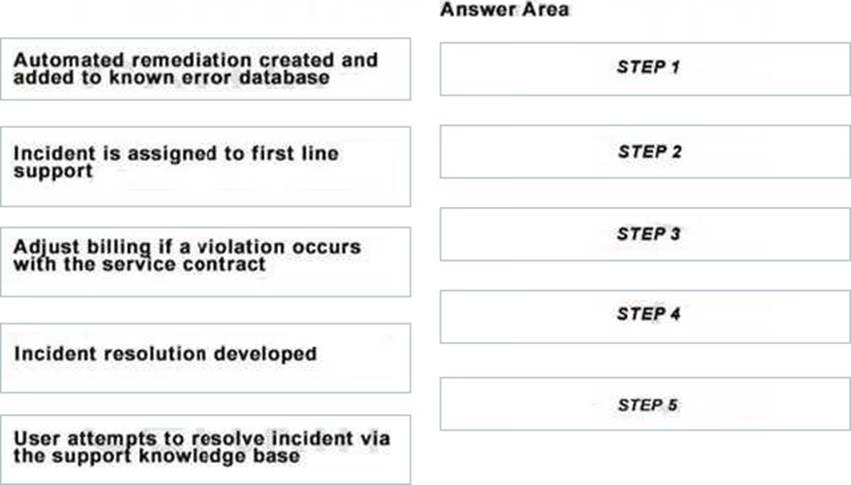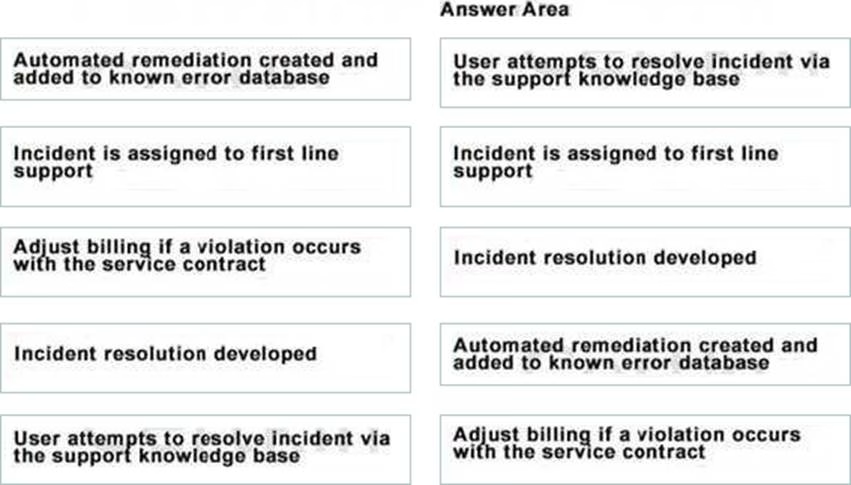DELL EMC D-CS-DS-23 Dell Cloud Services Design 2023 Online Training
DELL EMC D-CS-DS-23 Online Training
The questions for D-CS-DS-23 were last updated at Dec 09,2025.
- Exam Code: D-CS-DS-23
- Exam Name: Dell Cloud Services Design 2023
- Certification Provider: DELL EMC
- Latest update: Dec 09,2025
A line of business has been using a public cloud provider and is now seeking services from the internal IT department. The line of business (LOB) has concerns about service performance and availability.
They also want to have a clear and logical description of services, capabilities, and key performance indicators. The organization would like to better understand support responsibilities and warranties.
What should the LOB obtain from the IT department to satisfy concerns?
- A . SLO
- B . Service offering
- C . Service template
- D . SLA
An organization wants to provide IaaS capabilities in a private cloud.
They have the following requirements:
– Each line of business must have access to its own services and templates
– Service templates should be as generic as possible
– Data encryption should be provided for only services that require it
– Each instance should use Microsoft Active Directory for authentication
– Each instance should have the latest OS patches applied
How can these requirements be addressed in a cloud design?
- A . Add one template to the service catalog
Provide orchestration workflows to create a tenant and then instantiate and customize instances
Provide orchestration workflows to enable data encryption and authentication
Enable a configuration manager policy for OS updates - B . Add one template to the service catalog
Provide orchestration workflows to instantiate and customize instances
Provide orchestration workflows to enable data encryption and authentication
Enable a configuration manager policy for OS updates and tenant configuration - C . Configure multiple tenants in the service catalog
Add a template to the service catalog for each tenant
Provide orchestration workflows to instantiate and customize instances
Provide orchestration workflows to enable data encryption and authentication
Enable a configuration manager policy for OS updates - D . Configure multiple tenants in the service catalog
Add a single template to the service catalog
Provide orchestration workflows to instantiate and customize instances and then assign it to a tenant
Provide orchestration workflows to enable data encryption and authentication
Enable a configuration manager policy for OS updates
In the evolution of converged infrastructure, what are Blocks?
- A . Multi-persona factory fabricated systems with cloud deployment models included that are able to scale storage and compute independently
- B . Factory fabricated systems that offer a complete cloud with multiple personas on top of common hardware
- C . Single-personality infrastructure for customers that lack the expertise in house to deploy and manage Converged Systems
- D . Engineered systems designed to deliver discreet components in a predictable manner with a single personality
An IT organization for a medium sized grocery retailer is considering adopting ITaaS. They are interested in offering services to the lines of business through a service catalog. As a first step, they performed an inventory of all existing IT capabilities.
What would you recommend as a preferred approach to building services in their service catalog?
- A . Dedicate resources to build perfect services that go beyond customer needs
- B . Offer services that are of highest priority to IT in the service catalog
- C . Use an agile, iterative way to quickly build services through a phased approach
- D . Offer all IT capabilities as services to the customer to provide greater choice
A Chief Information Officer (CIO) of a financial services company is facing a peculiar dilemma. Any line of business (LOB) request for IT services takes too long to be delivered.
The core problem that has been identified is that there are multiple ways to order services that involve cumbersome processes with several manual and redundant steps. The CIO understands that the order and delivery process must move to a new model.
Which model would be most appropriate?
- A . Bi-modal IT
- B . Adaptive IT
- C . Lean IT
- D . Value IT
A company wants to deploy services in a new cloud infrastructure. The cloud architect is helping the company design services and realizes that the company is having trouble because of a legacy, organizational structure. The company is introducing multiple touch points into the service delivery process.
What impact will these additional touch points have on the process?
- A . Increase in the number of APIs.
- B . Increase in service catalog deployments
- C . Delays in service delivery
- D . Delays in metric collection
An IT organization has hired you as a cloud architect to assist them in planning for cloud services. Your first goal is to help the IT organization categorize existing services against service characteristics.
You have provided a table that shows common service characteristics and their attributes for considerations, benefits, and trade-offs.
The following attributes from the table have been identified:
– Consideration: bundling services increases complexity
– Benefit: replaceable components, improved recovery from failure
– Trade off: very finite capability
What characteristics correspond to the identified attributes?
- A . Discoverable, Composable, and Idempotent
- B . Discoverable, Reusable, and Autonomy
- C . Composable, Loosely Coupled, and Autonomy
- D . Idempotent, Loosely Coupled, and Reusable
An organization wants to use a public cloud provider for IaaS instances. They will develop and deploy their own applications within these instances. The organization must follow health care compliance regulations.
What should the organization ensure before deploying their applications in the public cloud?
- A . Instances will not be placed in more than one availability zone
- B . Auditors have access to the cloud provider’s data encryption keys
- C . Cloud provider supplies data-in-transit encryption capabilities
- D . Cloud provider supplies proper controls and audits for compliance requirements
An organization is categorizing their existing services against service characteristics to determine how ready each one might be for the catalog. Part of this effort involves looking at the following three attributes for each service characteristic: considerations, benefits, and trade-offs.
What attributes correspond to the following characteristics: Discoverable, Idempotent, and Composable?
- A . Consideration: standardized service contracts and metadata definitions
Benefit: improves reliability and scale
Tradeoff: complexity grows as number of services increases - B . Consideration: standardized service contracts and metadata definitions
Benefit: development and implementation cost reduction
Tradeoff: high degree of cooperation and agreement of design standards and conventions - C . Consideration: late or dynamic binding of services
Benefit: improves reliability and scale
Tradeoff: high degree of cooperation and agreement of design standards and conventions - D . Consideration: late or dynamic binding of services
Benefit: development and implementation cost reduction
Tradeoff: complexity grows as number of services increases
DRAG DROP
A company has an incident process in place for the cloud services that they support.
What is the correct order of steps for an incident process?

Latest D-CS-DS-23 Dumps Valid Version with 160 Q&As
Latest And Valid Q&A | Instant Download | Once Fail, Full Refund


